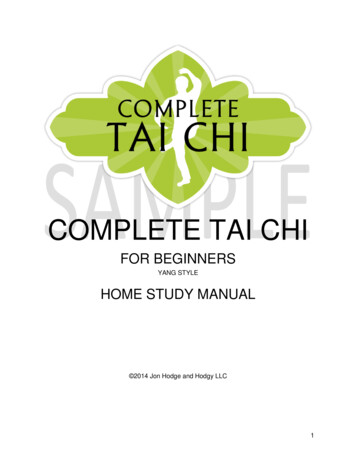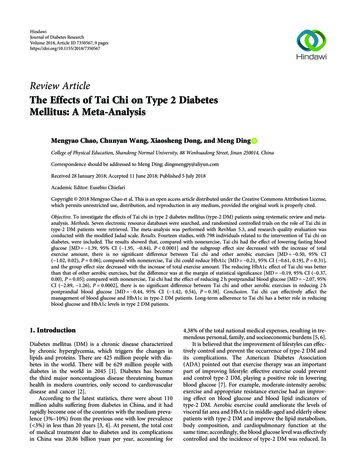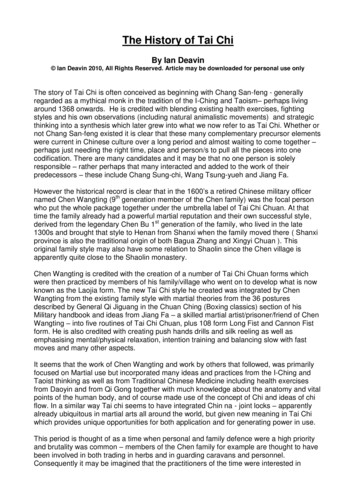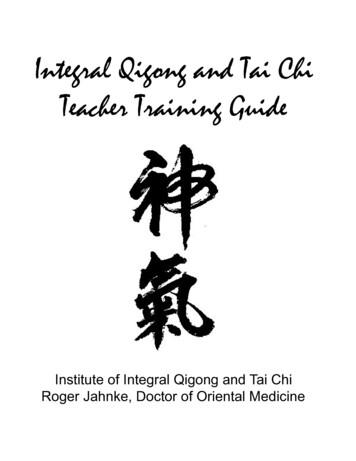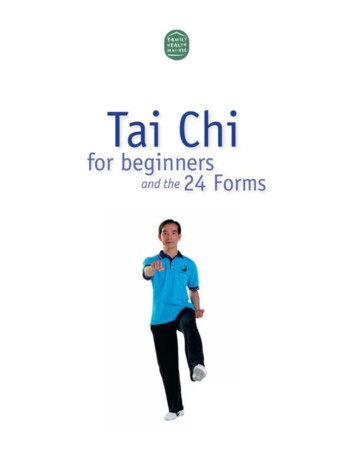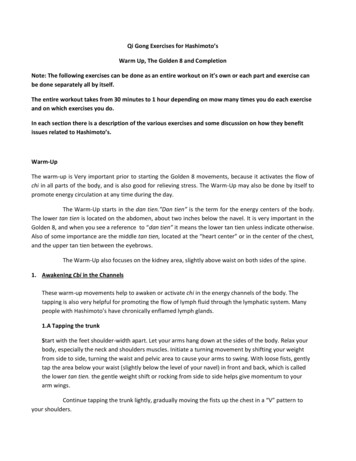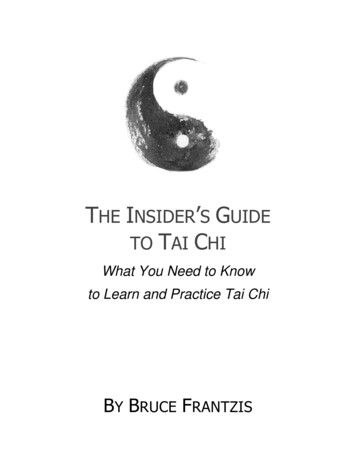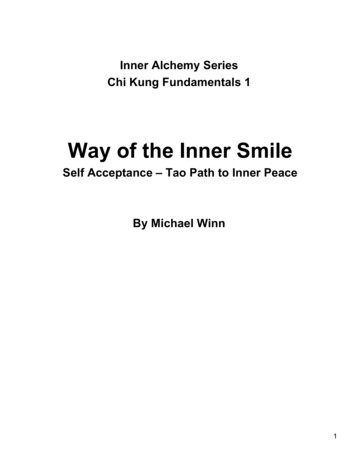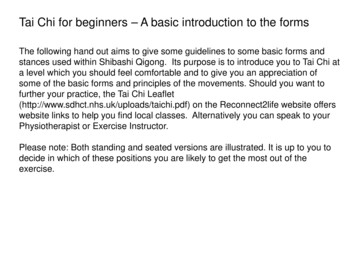
Transcription
Tai Chi for beginners – A basic introduction to the formsThe following hand out aims to give some guidelines to some basic forms andstances used within Shibashi Qigong. Its purpose is to introduce you to Tai Chi ata level which you should feel comfortable and to give you an appreciation ofsome of the basic forms and principles of the movements. Should you want tofurther your practice, the Tai Chi ) on the Reconnect2life website offerswebsite links to help you find local classes. Alternatively you can speak to yourPhysiotherapist or Exercise Instructor.Please note: Both standing and seated versions are illustrated. It is up to you todecide in which of these positions you are likely to get the most out of theexercise.
About Tai Chi (Shibashi Qigong)What is Shibashi Qigong?Tai Chi can be a dynamic or free flowing form of moving meditation which helps bring about calm and peace of mind whilst gentlyexercising the whole body and helps to enhance the flow of Qi (vital energy) within the body. Tai Chi is now widely practised and taught inevery major country of the world. It’s principles and methods make it readily accessible to people of all ages and ability.Shibashi Qigong (Shibashi meaning 18 movements in Chinese and Qigong is an ancient Chinese system of physical exercises andbreathing techniques) was developed through the Yang style that is one of the five traditional Tai Chi styles. Shibashi exercises unify thewhole of the system in a relaxed, focused and mindful way, what appears flowing and effortless on the outside is a result of cultivating deeprelaxation on the inside. Being mindful of the way we breathe and move, less of what we do becomes an unconscious reaction. This allowsus to remain calm and centered and in full control of all we do in life. Gentle Stretching and releasing, combined with deep relaxedbreathing encourages tensions deep in the body's tissues to soften and release.Where to practiceThis type of Qigong can be practiced indoors and outdoors. A quiet and peaceful environment should be chosen with good air circulation.Avoid practicing outside at times of severe weather such as thunderstorms or days with high smog alerts and strong winds.BreathingWhen practicing Shibashi Qigong we use a style of breathing called abdominal breathing or diaphragmatic breathing. You inhale throughyour nose and exhale through your mouth. It is deep breathing using the full extent of your lung capacity. It is called abdominal breathingbecause the movement of your diaphragm will expand your lower abdomen during the inhale and contract your lower abdomen during theexhale.How to startThis Qigong is very effective and easy to learn. However, you should not expect to remember all 18 movements at one time. You shouldbegin by practicing a few movements at a time. When practiced regularly, most people will be able to master all 18 movements within aweek. You should start to see some results if you practice this qigong exercise on a daily basis for three months.How to practiceShibashi Qigong can be practiced anywhere and in both standing and seated. Each movement should flow naturally and link seamlesslyfrom one to the other without any break in rhythm and form. Coordinate your whole body and relax the movements in time with yourbreathing keeping all your movements smooth and continuous.
1. Commencing form Stand with your feet shoulder width apartand your weight spread evenly acrossboth legs. Arms remain relaxed by yourside. Breathe in Raise your arms to shoulder level or aheight that feels acceptable. Keep yourelbows and wrists relaxed. Breathe out Lower your arms and wrist in a relaxedmanner.
2. Broadening one’s chest Stand with your feet shoulder width apart and your weightspread evenly across both legs. Arms remain relaxed byyour side. Breathe in Raise your arms to shoulder level or a height that feelsacceptable. Keep your elbows and wrists relaxed. Breathe out With your hands facing together, open your arms out andopen the chest. Allow your shoulders to relax. Breathe in Face your palms towards each other and bring your armsback to the middle. Remember to keep you shouldersrelaxed Breathe out Lower your arms to return to the beginning.
3. Dancing with Rainbows Breathe in Lift your right arm overhead with your elbow bentand shift your weight to the right hand side. Atthe same time extend your left arm out straight(the posture resembles an archer ready to firehis bow or a tea pot). Breathe in In a continuous movement raise your handsoverhead and shift your weight to the centre. Breathe out. Shift your weight across to the left hand side andmirror the form held previously on the right.
4. Circling arms Stand with your feet shoulder width apart andyour weight spread evenly across both legs.Your arms remain loose and relaxed. Yourhands are crossed with your palms facing yourbody. Breathe in Raise your arms up your body until your heador as high as you feel is comfortable. Breathe out Lower your arms in a circling movement to theoutside of your body and return to the startingposition.
5. Twisting waist and swing arms Turn your body at the waist toward your right side and keepyour knees slightly bent. Breathe in With the right arm down at the side of your body, palm facingup, draw your arm back in an arc, lifting your elbow towardsshoulder height (or as far as is comfortable). Breathe out Begin to rotate your wrist so that your palm will face forward.At the same time start bringing your right arm and bodyweight forward until the right arm is extended in front of you.Think of this move like front crawl in swimming. Repeat on your left side (Those who have been practicing fora while will be doing the movements simultaneously withboth arms but when beginning it is acceptable to move oneside at a time and easier to obtain good quality ofmovement).
6. Rowing the boat Breathe in Lift your arms back and overhead. Yourpalms face forwards. Breathe out Palms face forwards, push armsforwards and down as if you wererowing a boat.
7. Holding a ball Breathe in Turn your body from the waist towards theleft and reach across with your left armuntil shoulder height or as high as feelscomfortable. Breathe out Return to waist and left arm to yourstarting position. Now turn your body tothe right and reach your right arm acrosslike you did on the left hand side. Note: The idea of holding a ball isillustrated in the sitting photos to show theform, a ball is not needed for this exercise.
8.Carrying the moon Breathe in Turn your body towards the left from thewaist. Your shoulders are relaxed andyour elbows slightly bent. Now reachboth arms towards the left with your headfocusing on your hands. Breathe out Bring hands down. Turn to right andrepeat.
9. Twisting waist and push palms Breathe in Draw palms to the waist facing upwards. Breathe out Turn your body to the left at the waist. Keep the leftelbow and wrist slightly bent and the draw the elbowback. At the same time: extend the right arm forward and pushwith the right palm facing forward (as if you are trying tostop traffic). Breathe in Return to the middle and spread your weight evenlybefore turning to the right, drawing your left arm backand extending your left arm with your palm facingforward. If it helps just practice the movement with one arm at atime before you can co-ordinate both together. Gentlyshift from side to side and bend your knees.
10. Playing with clouds Breathe in With your arms relaxed (held out in front as ifcradling a baby) and palms facing towardsyou, turn to your left. Twist at the waist andbring your weight onto your left foot. Your gazeshould be directed towards your left handthroughout. Your right hand followsunderneath. Breathe out Rotate back to your original position. Breathe in Repeat the movement towards your right (Thistime your right hand will be the furthest fromyour middle).
11. Scooping from the sea Stand with your left foot forward, knee bentand weight shifted slightly toward your leftside. Breathing in Bend down forwards over your left knee andbring your hands together palms facing up. Bring your hands up over your head (or as faras is comfortable) whilst slowly separatingyour arms and transfer your weight onto yourright foot. Breathe out. Separate your arms and bend forward againto scoop from the sea.
12. Playing with waves Stand with your left foot forward. Breathe in Bend your elbows and bring your hands toyour shoulders with the palms facing forward.Your weight is on your back leg. Breathe out Push your arms forward and shift your weightonto your front leg with palms facing forward. Breathe in With your hands facing down bring yourweight back to the middle.
13. Spreading your wings Stand with your left foot forward. Breathe in Reach forward with your arm extended in frontof you. Your elbows should be relaxed andslightly bent. Aim for chest height or as high ascomfortable with your arms. Your hands faceeach other. If you feel confident allow your rightheel to lift off the floor as your come forward. Breathe out Move backwards transferring your weight ontoyour right foot. As you do this separate yourarms and spread them back like wings as far asyou feel comfortable. Again shoulders arerelaxed, elbows slightly bent and palms faceforwards.
14. Punching Stand with your feet shoulder width apart andyour weight spread evenly across both legs.Arms remain relaxed by the side with softfists. Breathe out Punch the right arm forward at chest level ifpossible. Breathe in Turn wrist over so that your fist facesupwards and draw your arm back to rest byyour side. Repeat with the left arm.
15. Flying like a wild goose Stand with your feet shoulder width apart andyour weight spread evenly across both legs . Breathe in Shift forward slightly to feel the weight of yourbody through the balls of your feet and lift yourarms sideways above your head. Your armsremain relaxed during this movement, yourpalms begin facing down and your wristsextend until they face away from your body andout to the sides. Breathe out Lower your arms down the side with wrists upand sink through your knees. You are nowflying like a wild goose.
16. Spinning wheels Stand with your feet shoulder width apartand your weight spread evenly across bothlegs. Let your arms lower in front of you,shoulders are relaxed, elbows bent andpalms facing each other. Breathe in Twist the body to the right and reaching outyour arms begin making a large circlingmovement with your palms facing eachother to until they are above your head. Breathe out Lower your arms on the left side of yourbody keeping the same distance betweenyour hands.
17. Bouncing the ball Stand with your feet shoulder width apartand your weight spread evenly across bothlegs . Transfer your weight onto your right foot. Breathe in Lift your left foot off the ground and yourright arm to shoulder height, palm facingdown. Breathe out Slowly drop your foot and arm. Repeat on the other side.
18. Pressing the palms Stand with your feet shoulder width apartand your weight spread evenly acrossboth legs. Rest your hands on top of eachother palms facing up. Breathe in Raise your hands up to chest height. Breathe out Turn your hands over to face down andslowly lower your arms.
Tai Chi can be a dynamic or free flowing form of moving meditation which helps bring about calm and peace of mind whilst gently exercising the whole body and helps to enhance the flow of Qi (vital energy) within the body. Tai Chi is now widely practised and taught in every major country of the world. It’s principles and methods make it .File Size: 1015KBPage Count: 20Explore furtherFree Tai Chi Exercises Sheets - XpCoursewww.xpcourse.comPrintable Tai Chi Exercises - XpCoursewww.xpcourse.comTai Chi Moves For Beginners: 7 Basic Stepscurejoy.comEzy Tai Chi: a simpler practice for seniorswww.icaa.ccTai Chi for Seniors: 3 Moves to Improve Balance and Stabilitywww.healthline.comRecommended to you b

